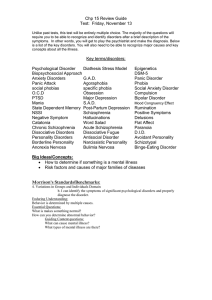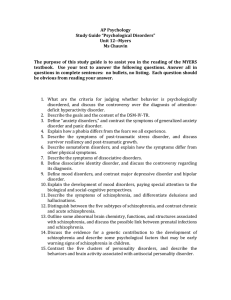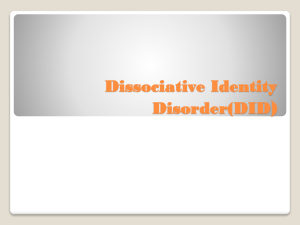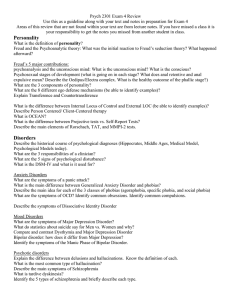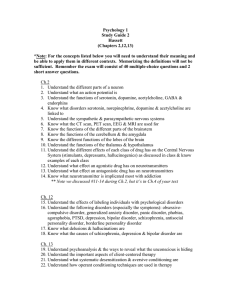Study Guide chapter14.doc
advertisement
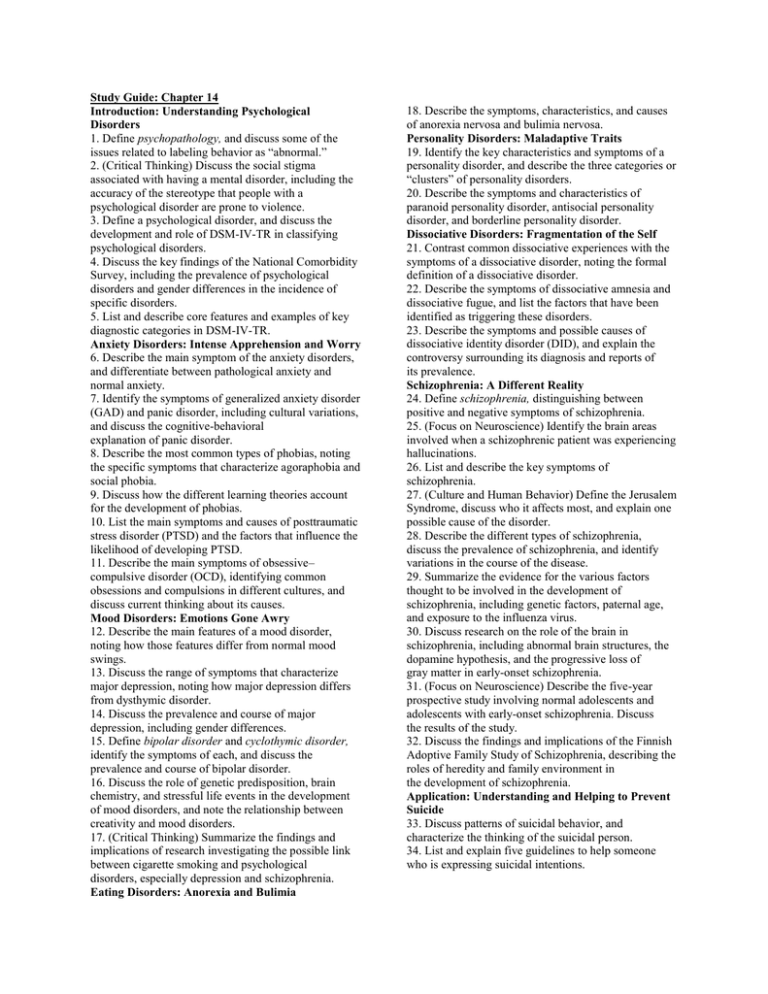
Study Guide: Chapter 14 Introduction: Understanding Psychological Disorders 1. Define psychopathology, and discuss some of the issues related to labeling behavior as “abnormal.” 2. (Critical Thinking) Discuss the social stigma associated with having a mental disorder, including the accuracy of the stereotype that people with a psychological disorder are prone to violence. 3. Define a psychological disorder, and discuss the development and role of DSM-IV-TR in classifying psychological disorders. 4. Discuss the key findings of the National Comorbidity Survey, including the prevalence of psychological disorders and gender differences in the incidence of specific disorders. 5. List and describe core features and examples of key diagnostic categories in DSM-IV-TR. Anxiety Disorders: Intense Apprehension and Worry 6. Describe the main symptom of the anxiety disorders, and differentiate between pathological anxiety and normal anxiety. 7. Identify the symptoms of generalized anxiety disorder (GAD) and panic disorder, including cultural variations, and discuss the cognitive-behavioral explanation of panic disorder. 8. Describe the most common types of phobias, noting the specific symptoms that characterize agoraphobia and social phobia. 9. Discuss how the different learning theories account for the development of phobias. 10. List the main symptoms and causes of posttraumatic stress disorder (PTSD) and the factors that influence the likelihood of developing PTSD. 11. Describe the main symptoms of obsessive– compulsive disorder (OCD), identifying common obsessions and compulsions in different cultures, and discuss current thinking about its causes. Mood Disorders: Emotions Gone Awry 12. Describe the main features of a mood disorder, noting how those features differ from normal mood swings. 13. Discuss the range of symptoms that characterize major depression, noting how major depression differs from dysthymic disorder. 14. Discuss the prevalence and course of major depression, including gender differences. 15. Define bipolar disorder and cyclothymic disorder, identify the symptoms of each, and discuss the prevalence and course of bipolar disorder. 16. Discuss the role of genetic predisposition, brain chemistry, and stressful life events in the development of mood disorders, and note the relationship between creativity and mood disorders. 17. (Critical Thinking) Summarize the findings and implications of research investigating the possible link between cigarette smoking and psychological disorders, especially depression and schizophrenia. Eating Disorders: Anorexia and Bulimia 18. Describe the symptoms, characteristics, and causes of anorexia nervosa and bulimia nervosa. Personality Disorders: Maladaptive Traits 19. Identify the key characteristics and symptoms of a personality disorder, and describe the three categories or “clusters” of personality disorders. 20. Describe the symptoms and characteristics of paranoid personality disorder, antisocial personality disorder, and borderline personality disorder. Dissociative Disorders: Fragmentation of the Self 21. Contrast common dissociative experiences with the symptoms of a dissociative disorder, noting the formal definition of a dissociative disorder. 22. Describe the symptoms of dissociative amnesia and dissociative fugue, and list the factors that have been identified as triggering these disorders. 23. Describe the symptoms and possible causes of dissociative identity disorder (DID), and explain the controversy surrounding its diagnosis and reports of its prevalence. Schizophrenia: A Different Reality 24. Define schizophrenia, distinguishing between positive and negative symptoms of schizophrenia. 25. (Focus on Neuroscience) Identify the brain areas involved when a schizophrenic patient was experiencing hallucinations. 26. List and describe the key symptoms of schizophrenia. 27. (Culture and Human Behavior) Define the Jerusalem Syndrome, discuss who it affects most, and explain one possible cause of the disorder. 28. Describe the different types of schizophrenia, discuss the prevalence of schizophrenia, and identify variations in the course of the disease. 29. Summarize the evidence for the various factors thought to be involved in the development of schizophrenia, including genetic factors, paternal age, and exposure to the influenza virus. 30. Discuss research on the role of the brain in schizophrenia, including abnormal brain structures, the dopamine hypothesis, and the progressive loss of gray matter in early-onset schizophrenia. 31. (Focus on Neuroscience) Describe the five-year prospective study involving normal adolescents and adolescents with early-onset schizophrenia. Discuss the results of the study. 32. Discuss the findings and implications of the Finnish Adoptive Family Study of Schizophrenia, describing the roles of heredity and family environment in the development of schizophrenia. Application: Understanding and Helping to Prevent Suicide 33. Discuss patterns of suicidal behavior, and characterize the thinking of the suicidal person. 34. List and explain five guidelines to help someone who is expressing suicidal intentions.

